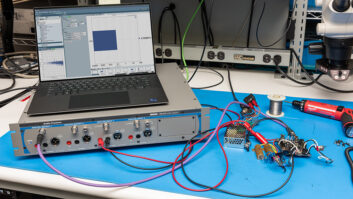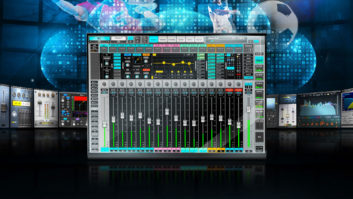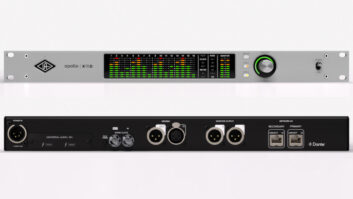
Over the past 10 years, with the decline in the number and staffs of commercial studios nationwide, recording schools have added to their curricula and students have found new opportunities in audio—videogame sound, house of worship sound, corporate sound, film sound, etc. But there has been very little attention to broadcast sound, by any of the leading schools, which seems a bit odd when you look at the size of the broadcast landscape.
In early 2014, the Conservatory of Recording Arts & Sciences in Tempe, Ariz., one of the nation’s leading audio schools, launched its Broadcast Sound component. “My goal for all students is employability,” says CRAS administrator Kirt Hamm. “Most come for music, but we want to expose them to other areas of the audio industry, too. Over the years we have spent more time in post-production for video, game audio, live sound and concert sound, the business side of music. The broadcast side came about after Fred Aldous approached us with what he did and asked if we had ever thought of a broadcast curriculum. He was pretty persistent.” [Laughs.]
Aldous, audio consultant and senior mixer, NFL and NASCAR, at Fox Sports, lives in Gilbert, Ariz., and is one of the top live sports mixers in the country. He had come up in the industry under the mentorship of the legendary, late sports mixer Bob Seiderman. And he had grown at Fox under the direction of Chairman David Hill. In 2005, he taught a guest class at CRAS, then a few more the following years. He took a nighttime course in Pro Tools and Logic Pro, met Robert Brock (who was then digital recording department director and now is director of broadcast audio) and proposed the development of a dedicated curriculum. There was a need in the industry to develop the next generation of audio mixers, he told them, and nobody was filling it.
“There has become a void of qualified mixers in broadcast, sports mixers especially,” he says. “The shows have become so complex, and we’re not onsite as long for each event, so there is no time to teach anybody on the job. We’re in and out and there’s no time to mentor. At the same time, the networks all want people with experience, but how do you get that experience?” Aldous invited Hamm and Brock to NYC for a Sports Video Group conference.
“We were pretty surprised about the conversation the audio side was having at SVG,” Hamm recalls. “They were clamoring for this need to be filled, which energized Brock and I. Then we went to the Giants NFL game and we saw the setup, the complexity. It was a great experience and exposed us to the fact that at the one football game they had 12-plus guys for audio-only.” They returned to Tempe and started developing a curriculum, writing their own textbook. At the same time they researched equipment and workflow to outfit a new studio and 42-foot mobile truck.
The three-week intensive Broadcast Audio component comes in Cycle 10 of a 12-Cycle program, so students come in well-grounded in signal flow, audio basics and recording/mixing. On the first day, a countdown timer is set for three weeks out, when the cycle culminates in a live-to-tape show run entirely by students. The goal is to expose students to broadcast audio, not make them A1s—there isn’t enough time for that.

The 42-foot mobile broadcast vehicle.
“There were two main areas we identified that would be unique to broadcast audio,” says Brock. “First is a true sense of pressure, that this show is not going to be delayed even 5 seconds because they’re not ready. It’s all about your preparation. Then we put them in an environment where they are have to respond to things like director calls—‘Roll A, track full’—what does that even mean? Our students get that exposure to the language, they learn how to selectively listen to a director while doing three other things. The other aspect is communication systems. Comms in a recording studio is pretty simplistic; comms in a broadcast scenario is absolutely crazy.”
“Comms is pretty much the heart and soul of a broadcast,” adds Aldous, who might be responsible for up to 500 lines during a Super Bowl. “If the director can’t talk to cameras, or producer can’t talk to tape operators or the audio mixer can’t listen to direction—if the comm systems are down, there is no show. I think we are one of the few if not the only schools that is teaching basic communications, as far as how to set up an IFB, a PL, point-to-point. That is a foundation of what we are doing.
“We’re also psychologists,” he continues, “and we work with announce talent much like a producer works with an artist. So we teach that. Also, how to interact with other departments in the production truck. You have to have rapport with the tape room, the graphics department, the technical director and your own audio crew. You have to be harmonious with your broadcast team. In live television, if you’re not ready at 1 o’clock when that ball is kicked, you’re being left behind.”
To launch the program, CRAS built nearly identical broadcast studio and mobile rooms, the only real difference being that the 42-foot gooseneck trailer has a 15-foot wide expando, and a Studer Vista 5 console. Studio E on the Gilbert campus has a Vista 9 with identical I/O, just a slightly different surface. Both have RTS comm systems, Studio Technologies Model 210 announce consoles and IFB, and 5.1 JBL LSR 6325 monitoring.
The decision to go with the Studers came after research into every major manufacturer of digital consoles. “We were looking for a real relationship with a manufacturer,” Hamm explains, “not just someone to sell us a console. We wanted a recognized platform, and we wanted something we could teach on. We were introduced to Michael Franklin and Katie Templeman-Holmes at Studer, and they got it. They saw benefit in our expertise of curriculum development and design. That’s how we started the Studer Broadcast Academy.”
Brock helped design a professional curriculum for the Vista Series in conjunction with Studer, and to date more than 1,000 users around the world have been certified through the online program.
Besides their class requirements, students have also been out with the mobile vehicle to two music festivals, the Potluck Conference, the Center for the Arts, and there are more excursions planned. The first class of students are now graduating, so the challenge is to place them in (required) internships, establishing all-new contacts with a whole new industry. No doubt there will soon be CRAS graduates helping bring Saturday afternoon college football over a station near you.







